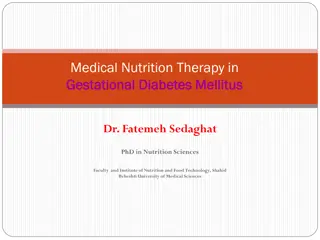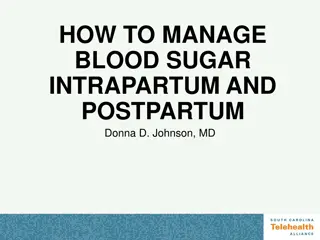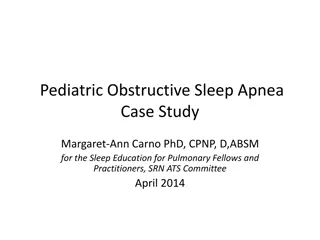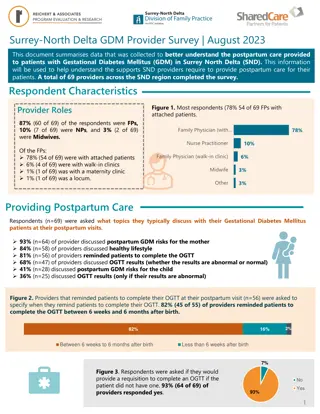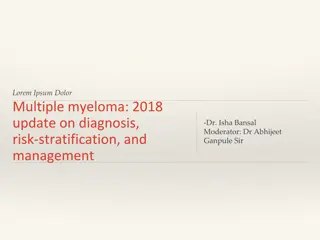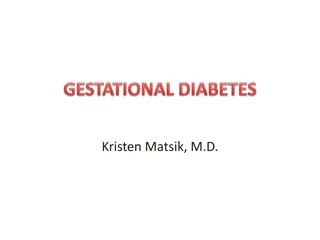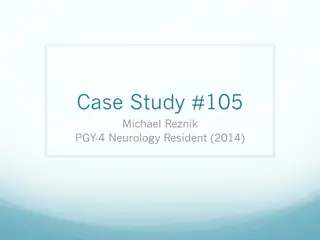
Diagnosis and Management of Gestational Diabetes Mellitus (GDM)
Learn about the diagnosis and management of Gestational Diabetes Mellitus (GDM) during pregnancy, including the significance, screening, and diagnostic testing. Discover insights into the terminology, prevalence, and potential complications associated with GDM.
Download Presentation

Please find below an Image/Link to download the presentation.
The content on the website is provided AS IS for your information and personal use only. It may not be sold, licensed, or shared on other websites without obtaining consent from the author. If you encounter any issues during the download, it is possible that the publisher has removed the file from their server.
You are allowed to download the files provided on this website for personal or commercial use, subject to the condition that they are used lawfully. All files are the property of their respective owners.
The content on the website is provided AS IS for your information and personal use only. It may not be sold, licensed, or shared on other websites without obtaining consent from the author.
E N D
Presentation Transcript
IN THE NAME OF GOD Diagnosis & Management of GDM
Pregnancy is accompanied by insulin resistance, mediated primarily by placental secretion of diabetogenic hormones including growth hormone, corticotropin-releasing hormone, placental lactogen, and progesterone. These and other metabolic changes ensure that the fetus has an ample supply of nutrients
TERMINOLOGY Historically, the term "gestational diabetes" has been defined as onset or first recognition of abnormal glucose tolerance during pregnancy Gestational diabetes describes diabetes diagnosed during the second half of pregnancy or glucose levels in early pregnancy that do not meet standard nonpregnant criteria for overt diabetes but are diagnostic for gestational diabetes mellitus, "overt diabetes" or "diabetes mellitus in pregnancy" describes diabetes diagnosed by standard nonpregnant criteria early in pregnancy
PREVALENCE: 6-7% in the United States (range 1-25%) 3.4%. The highest and lowest prevalence reported were 18.6% and 1.3% in, respectively, Karaj and Ardebil.
Significance Preeclampsia Hydramnios Macrosomia and large for gestational age infant Fetal organomegaly (hepatomegaly, cardiomegaly) Maternal and infant birth trauma Operative delivery Perinatal mortality Neonatal respiratory problems and metabolic complications (hypoglycemia, hyperbilirubinemia, hypocalcemia)
SCREENING AND DIAGNOSTIC TESTING Screening and diagnostic testing for diabetes are performed because identifying pregnant women with diabetes followed by appropriate therapy can decrease fetal and maternal morbidity, particularly macrosomia, shoulder dystocia, and preeclampsia
Two-step approach One-step approach The two-step approach is less sensitive than the one- step approach for diagnosis of gestational diabetes mellitus, and will miss approximately 25 percent of cases
Candidates for screening/testing Universal screening or testing appears to be the most practical approach Timing of screening/testing Performed as early as the first prenatal visit
The ADA and ACOG define women at increased risk of overt diabetes based on: Body mass index 25 kg/m2 ( 23 kg/m2 in Asian Americans) plus one or more of the following: Gestational diabetes mellitus in a previous pregnancy Glycated hemoglobin 5.7 percent, impaired glucose tolerance, or impaired fasting glucose on previous testing First-degree relative with diabetes High-risk race/ethnicity (eg, African American, Latino, Native American, Asian American, Pacific Islander)
History of cardiovascular disease Hypertension or on therapy for hypertension High-density lipoprotein cholesterol level <35 mg/d and/or a triglyceride level >250 mg/dL Polycystic ovary syndrome Physical inactivity Other clinical condition associated with insulin resistance (eg, severe obesity, acanthosis nigricans) Previous birth of an infant weighing 4000 Older age
Standard ADA criteria for diagnosis of diabetes in nonpregnant adults may be used to diagnose overt diabetes in early pregnancy: 1. A1C 6.5% 2. FPG 126mg/dl 3. 2 hour plasma glucose 200mg/dl during an OGTT 4. in a patient with classic symptoms of hyperglycemia
In the absence of early testing or if early testing is negative, universal screening is performed at 24 to 28 weeks of gestation
Screening methods 28 24 FBS 75 OGTT ) ( .
Patients unable to tolerate oral hyperosmolar glucose Serial glucose monitoring Fasting plasma glucose or A1C Test alternatives to the GCT and GTT Intravenous GTT
general approach to treatment of gestational diabetes mellitus Treatment of gestational diabetes can improve pregnancy outcome Identifying women with gestational diabetes mellitus is important to minimize maternal and neonatal morbidity: Preeclampsia Birth weight >4000 g Shoulder dystocia
NUTRITIONAL THERAPY Most women with gestational diabetes (70 to 85 percent) can achieve normoglycemia with nutritional therapy alone Meal plan :A typical meal plan for women with gestational diabetes mellitus includes three small- to moderate-sized meals and two to four snacks
After prescribing the diet, it is important to pay attention to subsequent changes in weight. Supplements EXERCISE
GLUCOSE MONITORING Frequency: at least 4 times a day Timing : For women with gestational diabetes mellitus, we suggest measuring blood glucose on awakening and after meals throughout pregnancy
Glucose target: ADA and ACOG glucose targets are: Fasting blood glucose concentration: <95 mg/dL One-hour postprandial blood glucose concentration: <140 mg/dL Two-hour postprandial glucose concentration: <120 mg/dL
The Hyperglycemia and Adverse Pregnancy Outcome study showed a continuous relationship between maternal glucose and adverse outcomes Glycated hemoglobin MONITORING FOR KETONURIA
PHARMACOLOGIC THERAPY Choice of pharmacologic therapy There are two pharmacologic options in pregnant patients who require medical therapy aimed at controlling blood glucose: Insulin (and some insulin analogs) and Selected oral antihyperglycemic agents (metformin, glyburide)
Insulin When to initiate: It is reasonable for women with fetuses with large abdominal circumferences to receive insulin to decrease the risk of macrosomia, even if they have no or mild hyperglycemia Dose: to start with the simplest regimen and increase the complexity as needed to address the particular situation
Type of insulin The three rapid-acting insulin analogs (lispro, aspart, glulisine) long-acting insulin analogs (insulin glargine, insulin detemir)
Oral antihyperglycemic agents Choice of glyburide versus metformin Patients who fail to achieve glycemic control with an oral agent
obstetrical issues and managment The clinician caring for pregnant women with GDM should be knowledgeable about the maternal and fetal risks related to the disorder, antepartum maternal and fetal assessment, use of obstetrical ultrasound to monitor fetal growth and well-being, decision-making about timing and route of delivery, intrapartum obstetric and glycemic management, and postpartum assessment and counseling
PREGNANCY MANAGEMENT Antenatal fetal testing Women on insulin or oral anti-hyperglycemic drugs or with poor glycemic control: ACOG has suggested antenatal fetal assessment beginning at 32 weeks of gestation for all women treated with insulin or oral agents Women euglycemic on nutritional therapy alone: No specific recommendations were made for fetal assessment in patients with well-controlled GDM on nutritional therapy
Assessment of fetal growth Ultrasound examination at 36 to 39 weeks to estimate fetal weight in all women with GDM An ultrasound examination early in the third trimester to identify fetal growth acceleration as this appears to be a sign of nonoptimal glycemic control
Timing of delivery A1 GDM: ACOG : delivery should not be planned before 39 weeks of gestation unless otherwise indicated, and that expectant management up to 40+6 weeks is generally appropriate with antepartum testing A2 GDM: induction of labor at 39 weeks of gestation Scheduled cesarean delivery: GDM and estimated fetal weight 4500 grams
Labor and delivery During labor, periodic assessment of maternal glucose levels and treatment of hyperglycemia is prudent Insulin requirements usually decrease during labor Women with GDM who were euglycemic without use of insulin or oral antihyperglycemic drugs during pregnancy do not normally require insulin during labor and delivery, and thus do not need their blood glucose levels checked hourly. Women with GDM who used insulin or oral antihyperglycemic drugs to maintain euglycemia occasionally need insulin during labor and delivery to maintain euglycemia.
For women undergoing scheduled cesarean delivery, insulin or antihyperglycemic drugs are withheld the morning of surgery and the woman is not allowed any oral intake after midnight.
POSTPARTUM MANAGEMENT AND FOLLOW-UP check glucose concentrations for 24 to 72 hours after delivery to exclude ongoing hyperglycemia Women who have fasting glucose levels below 126 mg/dL (7 mmol/L) after delivery should have a two-hour 75-gram oral glucose tolerance test 6 to 12 weeks postpartum to test for diabetes or prediabetes

![[PDF] DOWNLOAD READ Diagnosis Solving the Most Baffling Medical Mysterie](/thumb/9855/pdf-download-read-diagnosis-solving-the-most-baffling-medical-mysterie.jpg)





